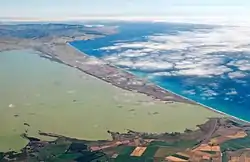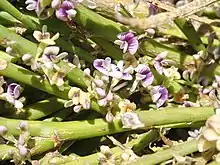Scythris niphozela
Scythris niphozela is a species of moth in the family Scythrididae. It is endemic to New Zealand. It is regarded as being endemic to the Kaitorete Spit area although previously it had been recorded in the Manorburn Ecological District. This species inhabits the foredune area of Kaitorete Spit. The larvae feed on Carmichaelia appressa. Adults are day flying and are on the wing from October to December. These moths are not attracted to light. The species are classified as "At Risk, Naturally Uncommon" by the Department of Conservation.
| Scythris niphozela | |
|---|---|
.jpg.webp) | |
| male | |
| Scientific classification | |
| Domain: | Eukaryota |
| Kingdom: | Animalia |
| Phylum: | Arthropoda |
| Class: | Insecta |
| Order: | Lepidoptera |
| Family: | Scythrididae |
| Genus: | Scythris |
| Species: | S. niphozela |
| Binomial name | |
| Scythris niphozela | |
Taxonomy
This species was originally described by Edward Meyrick in 1931 using specimens collected by Stewart Lindsay at Birding's Flat in December.[2][3] George Hudson discussed and illustrated this species in his 1939 publication A supplement to the butterflies and moths of New Zealand.[4] The holotype specimen is held at the Canterbury Museum.[3]
Description
Meyrick described the species as follows:
♂︎♀︎. 9-10mm - Head, palpi, thorax dark grey, more or less mixed or suffused white. Abdomen iridescent whitish grey, ♂︎ anal tuft tinged ochreous, ♀︎ basal third suffused blackish above, apex blackish beneath. Forewings elongate-lanceolate ; dark grey posteriorly or nearly wholly suffused white ; an irregular fascia of blackish suffusion from dorsum before middle ; not reaching costa ; a slightly narrower suffused blackish fascia from tornus, hardly reaching above middle ; in whiter examples both these may be connected with costa by irregular grey marks ; cilia grey, round apex, more or less suffused white. Hindwings 4 or 5 coincident ; bronze-grey-whitish, apex greyer ; in ♀︎ a thick streak of black suffusion along dorsum from near base to near middle ; cilia light ochreous-grey.[2]
Distribution

This species is endemic to New Zealand.[5][1] Other than the type locality of Birdings Flat at Kaitorete Spit,[2] this species has been recorded by Brian Patrick as being found at Long Valley Ridge in the Manorburn Ecological District, Central Otago in February.[6][7] However in 1994 Patrick described S. niphozela as being endemic to the Kaitorete Spit area.[8]
Biology and life history
The larvae emerge from their eggs during October to December.[9] This species is day flying and on the wing in October to December.[4][8] S. niphozela are not attracted to light traps.[10]
Host species and habitat

Larvae of this species has been found on Carmichaelia appressa, an endemic species of plant at the Kaitorete Spit.[8] The moth inhabits the foredune area of this land formation and is regarded as being endemic to the gravel barrier present there.[8][10]
References
- "Scythris niphozela Meyrick, 1931". www.nzor.org.nz. Landcare Research New Zealand Ltd. Retrieved 2018-05-26.
- Meyrick, E. (1931). "Notes on New Zealand Lepidoptera". Records of the Canterbury Museum. 3: 367–369.
- Dugdale, J. S. (1988). "Lepidoptera - annotated catalogue, and keys to family-group taxa" (PDF). Fauna of New Zealand. 14: 110. Archived from the original (PDF) on 2019-07-22. Retrieved 2018-05-26 – via Landcare Research New Zealand Ltd.
- Hudson, G. V. (1939). A supplement to the butterflies and moths of New Zealand. Wellington: Ferguson & Osborn. p. 459. OCLC 9742724.
- Gordon, Dennis P., ed. (2010). New Zealand inventory of biodiversity: Kingdom animalia : chaetognatha, ecdysozoa, ichnofossils. Vol. 2. p. 463. ISBN 978-1-877257-93-3. OCLC 973607714. OL 25288394M. Wikidata Q45922947.
- Patrick, Brian (1989). Lepidoptera, Cicadidae, Acrididae of the Manorburn Ecological District (PDF). Wellington, N.Z.: Department of Conservation. ISBN 978-0478011449. OCLC 154271965.
- Patrick, Brian (1989). "Appendix I of Lepidoptera, Cicadidae, Acrididae of the Manorburn Ecological District" (PDF). www.doc.govt.nz. Retrieved 25 May 2018.
- Patrick, B (1994). "Lepidoptera of Kaitorete Spit, Canterbury". New Zealand Entomologist. 17 (1): 52–63. CiteSeerX 10.1.1.580.6402. doi:10.1080/00779962.1994.9721985.
- Brian Patrick (1 December 2014). "Conservation status of five data deficient moth taxa: Epichorista lindsayi, "Cnephasia" paterna, Stathmopoda endotherma, Gymnobathra ambigua and Scythris "stripe"". The Wētā. 48: 15–34. ISSN 0111-7696. Wikidata Q105343576.
- Patrick, Brian (2014). "Conservation status of five data deficient moth taxa: Epichorista lindsayi, "Cnephasia" paterna, Stathmopoda endotherma, Gymnobathra ambigua and Scythris "stripe"". The Weta. 48: 15–35.